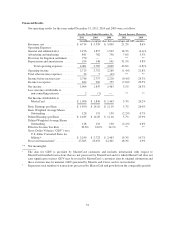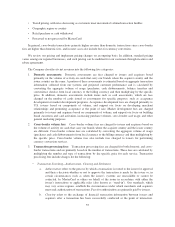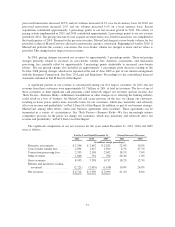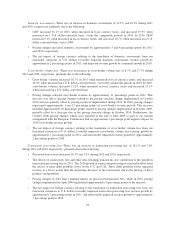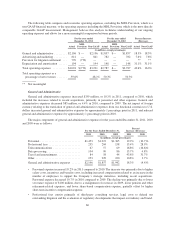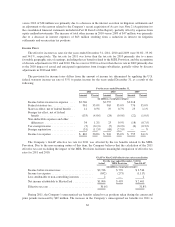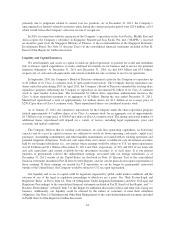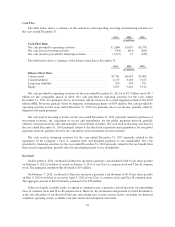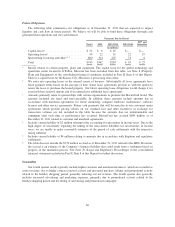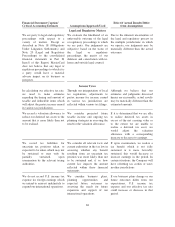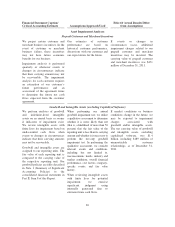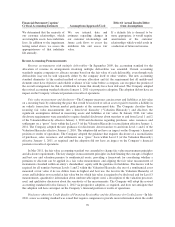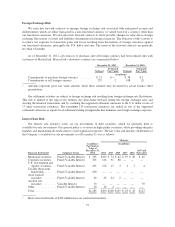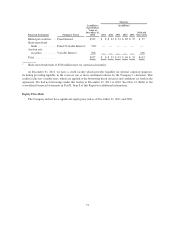MasterCard 2011 Annual Report Download - page 67
Download and view the complete annual report
Please find page 67 of the 2011 MasterCard annual report below. You can navigate through the pages in the report by either clicking on the pages listed below, or by using the keyword search tool below to find specific information within the annual report.primarily due to judgments related to current year tax positions. As of December 31, 2011, the Company’s
unrecognized tax benefits related to positions taken during the current and prior period were $214 million, all of
which would reduce the Company’s effective tax rate if recognized.
In 2010, in connection with the expansion of the Company’s operations in the Asia Pacific, Middle East and
Africa region, the Company’s subsidiary in Singapore, MasterCard Asia Pacific Pte. Ltd. (“MAPPL”), received
an incentive grant from the Singapore Ministry of Finance, at the recommendation of the Singapore Economic
Development Board. See Note 19 (Income Taxes) to the consolidated financial statements included in Part II,
Item 8 of this Report for further discussion.
Liquidity and Capital Resources
We need liquidity and access to capital to fund our global operations, to provide for credit and settlement
risk, to finance capital expenditures, to make continued investments in our business and to service our potential
litigation obligations. At December 31, 2011 and December 31, 2010, we had $4.9 billion and $3.9 billion,
respectively, of cash and cash equivalents and current available-for-sale securities to use for our operations.
In September 2010, the Company’s Board of Directors authorized a plan for the Company to repurchase up
to $1 billion of its Class A common stock in open market transactions. The Company did not repurchase any
shares under this plan during 2010. In April 2011, the Company’s Board of Directors amended the existing share
repurchase program authorizing the Company to repurchase an incremental $1 billion of its Class A common
stock in open market transactions. The incremental $1 billion share repurchase authorization increases the
Class A share repurchase program to an aggregate of $2 billion. During the year ended December 31, 2011,
MasterCard repurchased a total of approximately 4.4 million shares for $1.1 billion at an average price of
$258.92 per share of Class A common stock. These repurchased shares are considered treasury stock.
As of January 27, 2012, the cumulative repurchases by the Company under the share repurchase program
totaled approximately 4.7 million shares of its Class A common stock for an aggregate cost of approximately
$1.3 billion at an average price of $264.65 per share of Class A common stock. The timing and actual number of
additional shares repurchased will depend on a variety of factors, including legal requirements, price and
economic and market conditions.
The Company believes that its existing cash balances, its cash flow generating capabilities, its borrowing
capacity and its access to capital resources are sufficient to satisfy its future operating cash needs, capital asset
purchases, outstanding commitments and other liquidity requirements associated with its existing operations and
potential litigation obligations. Cash and cash equivalents and current available-for-sale investment securities
held by our foreign subsidiaries (i.e., any entities where earnings would be subject to U.S. tax upon repatriation)
was $1.8 billion and $1.1 billion at December 31, 2011 and 2010, respectively, or 37% and 28% of our total cash
and cash equivalents and current available-for-sale investment securities as of such dates. It is our present
intention to permanently reinvest the undistributed earnings associated with our foreign subsidiaries as of
December 31, 2011 outside of the United States (as disclosed in Note 19 (Income Tax) to the consolidated
financial statements included in Part II, Item 8 of this Report), and our current plans do not require repatriation of
these earnings. If these earnings are needed for U.S operations or can no longer be permanently reinvested
outside of the United States, the Company would be subject to U.S. tax upon repatriation.
Our liquidity and access to capital could be negatively impacted by global credit market conditions and the
outcome of any of the legal or regulatory proceedings to which we are a party. See “Risk Factors-Legal and
Regulatory Risks” in Part I, Item 1A; Note 18 (Obligations Under Litigation Settlements) and Note 20 (Legal and
Regulatory Proceedings) to the consolidated financial statements included in Part II, Item 8 of this Report; and “—
Business Environment “ in Part II, Item 7 of this Report for additional discussion of these and other risks facing our
business. Additionally, our liquidity could be affected by the failure of customers to meet their settlement
obligations. See Note 21 (Settlement and Other Risk Management) to the consolidated financial statements included
in Part II, Item 8 of this Report for further discussion.
63


